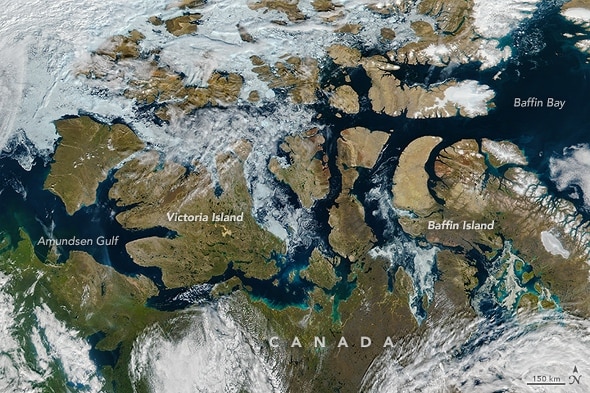Create a free profile to get unlimited access to exclusive videos, sweepstakes, and more!
Global Warming Has Now Made the Northwest Passage a Thing

More than a century ago, explorers dreamed of a Northwest Passage, a route from the Pacific Ocean to the Atlantic by plying the waterways north of Canada, threading through the Canadian Arctic Archipelago, huge icy islands north of the Canadian mainland.* Such a trip was fantastically dangerous and well-nigh impossible, since in the winter and even most of the summer, the waterways were either frozen solid or littered with huge blocks of ice.
Roald Amundsen was the first to successfully make his way through. It took him three years in a small ship starting in 1903, and included getting stuck in ice three times.
Fast-forward. On Aug. 16—just days ago—a 250-meter-long, 1,070 passenger cruise ship, the Crystal Serenity, set sail, and is expected to make its way through the Northwest Passage in just eight days.
How can it do so? Global warming.
Over the past few years, the Arctic has warmed so much that the fabled passage has become a reality. The ice melts so much in the summer that it’s not only possible for ships to make their way through the archipelago, but it may be commercially viable to do so.
To be clear, quite a few ships have made the passage since 2007, the first year the ice had melted enough to make it far easier to cross. But it’s been a struggle, and bigger ships have a more difficult time. On average, every year it gets easier as the ice melts away due to the increased heat in the Earth’s northern regions.
Deniers of global warming will make sidetracking claims, talking about how Antarctic ice is increasing (it isn’t), or other non sequiturs (note: In a massive irony, even the fossil fuel companies funding so much climate change denial accept that the Arctic is melting, and are scrambling for rights to drill for oil there). The reality is that the Arctic is warming at a rate twice as fast as the rest of the planet—temperatures in the Arctic have been more than seven degrees Celsius higher than average—and the ice up there is melting so fast that it’s been called a “death spiral.”
And understandably so. Watch:
There are two ways to measure Arctic ice: extent and volume. Volume is obvious enough; it’s literally the volume of ice. Extent is similar to the area covered by ice but is technically defined as the amount of area covered by more than 15 percent ice in a given region. Both have decreased dramatically in the past couple of decades, but the extent is more important for the Northwest Passage. Warmer summers mean the ice doesn’t freeze as much in the winter, so it’s thinner and melts more easily the next summer. That makes getting through with a ship easier.
The record low extent for Arctic ice was in 2012. That was an unusual year; an ice dam collapsed, allowing warmer waters to move north, melting ice far more than normal. Arctic ice hits its minimum extent in September every year, and this year is on course to be among the lowest ever seen.
If you click that graph, you’ll be taken to an interactive version. Click the years to see the ice extent over time. You’ll note that 2012 was indeed the record low, but every year over the past 10 years has been far, far below average.
That’s because of global warming. Experts predict we’ll see our first ice-free Arctic summer around 2040, and given the downward trend of ice extent, that sounds about right. Mind you, this is inevitable; even if we stopped burning fossil fuels today, stopped pouring carbon dioxide into our air, the damage is already done. Warming would continue for decades, perhaps centuries, and the Arctic ice will melt. The same is true for Antarctica; the trajectory of warming means that the western glaciers of that continent are almost certainly doomed to melt away no matter what we do now.
It’s not too late to save our planet, though. There are things we can do. Enact a carbon tax, for one. Switch to renewable energy for another, which is completely doable.
And third? Vote science deniers out of office. They inhabit not only the U.S. Congress but also political seats all over the world.
When it comes time to vote, vote. Climate change is important enough to make it a one-issue election, but some people feel that’s not enough to sway them. But really that’s a matter of framing. Chances are those who deny the reality of climate change deny lots of other science, too. When that one issue is reality itself, then damn straight this is a one-issue election.
*Correction, Aug. 22, 2016: I originally wrote the islands were north of Canada, implying (unintentially) that they are not part of Canada, when they actually are.


























